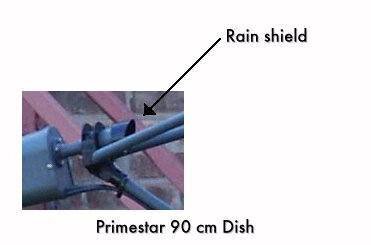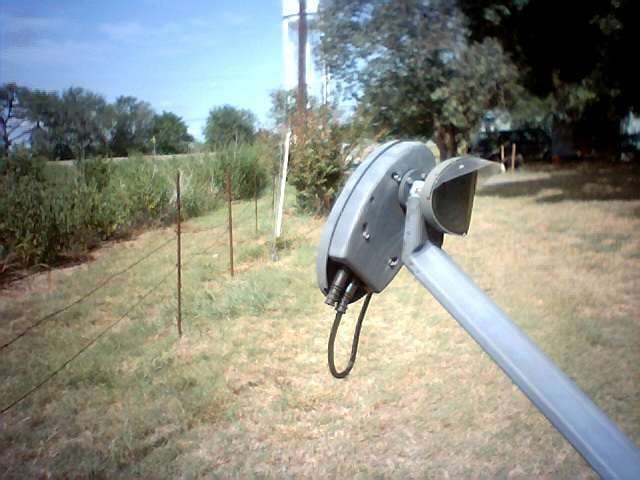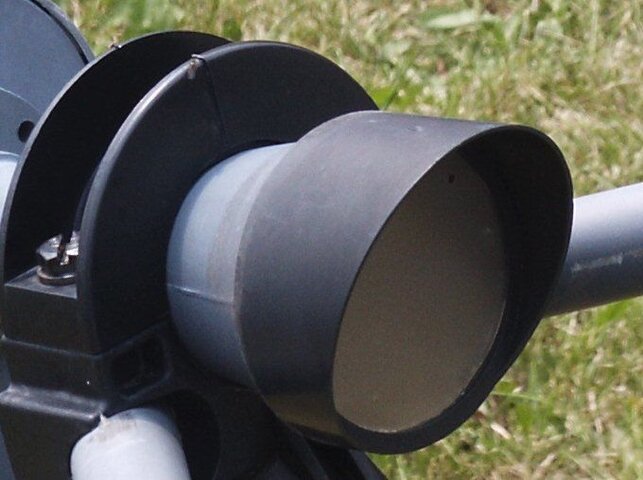 :I wonder if anyone ever tried fabricating the Primestar rain shield idea to other LNBF's? (see attached picture) Since ku gets attenuated by raindrops I wonder if this would help keep the lnb lens dry and cut down on signal loss? Primesat did it for some reason. Any Input
:I wonder if anyone ever tried fabricating the Primestar rain shield idea to other LNBF's? (see attached picture) Since ku gets attenuated by raindrops I wonder if this would help keep the lnb lens dry and cut down on signal loss? Primesat did it for some reason. Any InputPrimesatar Rain shield idea
- Thread starter tvropro
- Start date
- Latest activity Latest activity:
- Replies 16
- Views 3K
You are using an out of date browser. It may not display this or other websites correctly.
You should upgrade or use an alternative browser.
You should upgrade or use an alternative browser.
- Status
- Please reply by conversation.
Just a guess, but I would think the rain-fade problem comes from rain between the dish and the satellite, and what hits the dish is minimal. Rain usually comes from the south around here, I've seen the signal drop or go out when no rain is falling yet at my dishes. Maybe the shield helps some though.
The lens shade is a very good idea. While heavy rain or thick cloud cover can result in a loss of signal, severe attenuation (with the least amount of water) is caused by water sheeting across the lens of the feedhorn.
An example of a product developed to lessen the affect of water collecting on a surface is Rain Shield. Rain Shield was developed for reducing the rain sheeting problems with mobile satellite dishes. Mobile domes have a problem with even light rain standing or sheeting on the dome of the system attenuating and often eliminating the satellite signals resulting in loss of signal.
We have participated in tests where controlled amounts of water were sprayed onto the lens of an LNBF. The quality readings were consistently higher using a LNBF with Rain Shield applied.
An example of a product developed to lessen the affect of water collecting on a surface is Rain Shield. Rain Shield was developed for reducing the rain sheeting problems with mobile satellite dishes. Mobile domes have a problem with even light rain standing or sheeting on the dome of the system attenuating and often eliminating the satellite signals resulting in loss of signal.
We have participated in tests where controlled amounts of water were sprayed onto the lens of an LNBF. The quality readings were consistently higher using a LNBF with Rain Shield applied.
Just a guess, but I would think the rain-fade problem comes from rain between the dish and the satellite, and what hits the dish is minimal. Rain usually comes from the south around here, I've seen the signal drop or go out when no rain is falling yet at my dishes. Maybe the shield helps some though.
The lens shade is a very good idea. While heavy rain or thick cloud cover can result in a loss of signal, severe attenuation (with the least amount of water) is caused by water sheeting across the lens of the feedhorn.
An example of a product developed to lessen the affect of water collecting on a surface is Rain Shield. Rain Shield was developed for reducing the rain sheeting problems with mobile satellite dishes. Mobile domes have a problem with even light rain standing or sheeting on the dome of the system attenuating and often eliminating the satellite signals resulting in loss of signal.
We have participated in tests where controlled amounts of water were sprayed onto the lens of an LNBF. The quality readings were consistently higher using a LNBF with Rain Shield applied.
I got a good closeup today of my P* lnb's cover. Next Im going to try to figure out something for the Geosat LNBF's.
Attachments
I have used a clear 20oz plastic Coke bottle before when I had them break on my Primestar dishes. The center of the bottle is about the same diameter, it is clear plastic, and fits pretty well.
You can cut it with scissors, and then put on a little plastic glue and a rubber band overnight, and it is there forever.
Fred
You can cut it with scissors, and then put on a little plastic glue and a rubber band overnight, and it is there forever.
Fred
TVROPro, that is the same feedhorn cover that is on my 1M Channel Master. There are a series of small holes in a semi-arc at the top of the plastic covering the horn throat. The dish gets very acceptable results during most rainstorms 
... small holes in a semi-arc at the top of the plastic covering the horn throat...
Important feature because condensation will form without some ventilation. Not a good idea at all to seal the thing up airtight.
In the early days (opps here he goes again), before Corotors, I made a pyramid shaped feed horn flanged to the LNA (the LNA was rotated with an over-the-air antenna rotor for horiz. and vert. transponders). At times, it would become overcome with sparklies that I couldn't explain. Finally noticed about a half teaspoon of condensation inside the lens. Spaced the lense to create a gap and never had a problem after that. This was way before Ku.
Harold
TVROPro, that is the same feedhorn cover that is on my 1M Channel Master. There are a series of small holes in a semi-arc at the top of the plastic covering the horn throat. The dish gets very acceptable results during most rainstorms
Yep that's the picture from my 90cm Primestar dish, it has the little holes. I need to devise some sort of cover for my Geosat lnbf's on my ADTH dish. The Primestar works much better in the rain.
Important feature because condensation will form without some ventilation. Not a good idea at all to seal the thing up airtight.
In the early days (opps here he goes again), before Corotors, I made a pyramid shaped feed horn flanged to the LNA (the LNA was rotated with an over-the-air antenna rotor for horiz. and vert. transponders). At times, it would become overcome with sparklies that I couldn't explain. Finally noticed about a half teaspoon of condensation inside the lens. Spaced the lense to create a gap and never had a problem after that. This was way before Ku.
Harold
On my original poloroter (back in the day) I had a problem with sparklies after rainstorms for days. Removed the cap and water would come out. Since then (1987) I have run C band with no cover at all. First on my Chap feed's then on my ADL (current) feed. Never had this problem again.
I have used a clear 20oz plastic Coke bottle before when I had them break on my Primestar dishes. The center of the bottle is about the same diameter, it is clear plastic, and fits pretty well.
You can cut it with scissors, and then put on a little plastic glue and a rubber band overnight, and it is there forever.
Fred
I have to make a hood but I also have to make sure it will not get in the path of the signal coming in to the lnbf. R & D time again
Hey tvropro,
What I was referring to was the hood.
The clear plastic will not interfere with the incoming signal. For one thing, the LNBf is more than likely lower than the signal stream, and the other thing is that what it does get in the way of, will pass through.
Fred
What I was referring to was the hood.
The clear plastic will not interfere with the incoming signal. For one thing, the LNBf is more than likely lower than the signal stream, and the other thing is that what it does get in the way of, will pass through.
Fred
Hey tvropro,
What I was referring to was the hood.
The clear plastic will not interfere with the incoming signal. For one thing, the LNBf is more than likely lower than the signal stream, and the other thing is that what it does get in the way of, will pass through.
Fred
Ok Fred, I just wasn't sure if you meant the hood or cap. The Geosat lnbf are small so a 20 oz coke bottle will be a bit large. Im not sure if I want to keep it straight or tapered like the P* is. I have to do some thinking. With your idea's on your P* 2 lnbf setup, it gave me some good input to get my job done. I think it turned out very well. A few of us should get into custom designing add on's for dishes. When my mind get's working I can come up with some interesting stuff.
Make sure that the shield doesn't block any of the reflector view from the feedhorn. If water, snow or contaminants sit on top of the shield, the RF passive material will become a RF block.
To test if the shield is blocking, cover the shield with foil. If the signal and or quality drops, trim the hood back and retest.
An application of Rain Shield to the lens of the LNBF twice a year will also solve the problem.
To test if the shield is blocking, cover the shield with foil. If the signal and or quality drops, trim the hood back and retest.
An application of Rain Shield to the lens of the LNBF twice a year will also solve the problem.
Make sure that the shield doesn't block any of the reflector view from the feedhorn. If water, snow or contaminants sit on top of the shield, the RF passive material will become a RF block.
To test if the shield is blocking, cover the shield with foil. If the signal and or quality drops, trim the hood back and retest.
An application of Rain Shield to the lens of the LNBF twice a year will also solve the problem.
I put some rain hoods together today and did some testing then installed them. My quality didn't change. Then the sky's got really dark and we got a rain shower. I lost G-10 before it started to rain (heavy cloud cover) and it came back once it started raining. I went outside and it seems like the hood was protecting 75% of the lnb cap from rain I noticed my Q numbers seem to be higher than normal while raining.
I made the hood with a tapered design like on my Primestar. I put some RainX on the lnb covers the other day. What's the difference with Rain Shield? It's all about having water roll off the lnb lens and not collecting there right?
- Status
- Please reply by conversation.
Similar threads
- Replies
- 6
- Views
- 940
- Replies
- 7
- Views
- 1K
- Replies
- 6
- Views
- 2K
- Replies
- 1
- Views
- 1K




